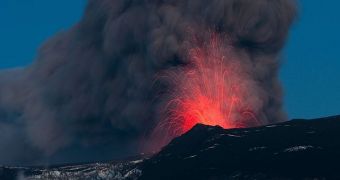The Laki eruption of 1783, while unknown to many, was a massive volcanic eruption in southern Iceland that led to the production of massive acid rain clouds throughout Europe. Scientists now warn that this could happen again, were a similar eruption to occur at this point.
Over the past couple of years, two major eruptions occurred in Iceland, indications of the turmoil going on below the planetary surface at this geologically-active location. Both of these events – Grímsvötn and Eyjafjallajökull – had significant repercussions on Europe, but the former was the worse.
The 2010 event caused the majority of major airports in Europe to shut down, producing incalculable economic and environmental damages. But even its strength pales in comparison to that of the Laki eruption, all those centuries ago.
In a paper published in the September 19 issue of the esteemed journal Proceedings of the National Academy of Sciences (PNAS), experts at the University of Leeds say that an 8-month eruption in Iceland could release enough sulfur dioxide to produce impressive acid rain clouds.
These clouds would then be pushed by prevailing winds all over Europe, causing widespread public health crisis as people would become exposed to the damaging moisture and rain. Second-order consequences would involved a rise in the incidence of skin cancers and other similar conditions.
Within a single year, as many as 140,000 premature deaths could be registered, the investigators warn. They add that this number is several times higher than that of people dying from seasonal flu infections every single season.
Other than Iceland itself, the United Kingdom would be the worst affected country, given its close proximity to the island. Heart and lung diseases would claim an additional 20,000 lives the first year in the nation.
“The two recent Icelandic eruptions of Eyjafjallajökull and Grímsvötn have raised public awareness of the risks posed by volcanic ash to commercial aviation in the UK and beyond,” Leeds School of Earth and Environment expert and lead study author Dr. Anja Schmidt explains.
“But ash clouds are only half the story. The eight-month-long eruption of Laki in 1783 was one of the most devastating volcanic events in Iceland's history,” the investigator goes on to say.
“The eruption did not produce significant amounts of ash – but instead emitted about 122 megatons of sulfur dioxide into the atmosphere, more than all global man-made emissions in a year. Laki-style events have occurred several times during the last 1,000 years,” the expert concludes.

 14 DAY TRIAL //
14 DAY TRIAL //